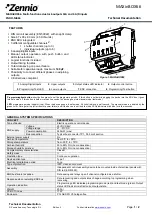
118
CHAPTER 5 CLOCK GENERATOR
User’s Manual U15798EJ2V0UD
5.4 System Clock Oscillator
5.4.1 Main system clock oscillator
The main system clock oscillator oscillates with a crystal resonator or a ceramic resonator (10 MHz TYP.) connected
to the X1 and X2 pins.
External clocks can be input to the main system clock oscillator. In this case, input a clock signal to the X1 pin
and an inverted-phase clock signal to the X2 pin.
Figure 5-5 shows an external circuit of the main system clock oscillator.
Figure 5-5. External Circuit of Main System Clock Oscillator
(a) Crystal and ceramic oscillation
(b) External clock
Crystal resonator or
ceramic resonator
X2
X1
External
clock
X2
X1
IC
V
SS1
Cautions 1. Do not execute the STOP instruction and do not set MCC (bit 7 of processor clock control
register (PCC)) to 1 if an external clock is input. This is because when the STOP instruction
or MCC is set to 1, the main system clock operation stops and the X2 pin is connected to V
DD1
via a pull-up resistor.
2. When using the main system clock oscillator and subsystem clock oscillator, wire as follows
in the area enclosed by the broken lines in the Figures 5-5 and 5-6 to avoid an adverse effect
from wiring capacitance.
• Keep the wiring length as short as possible.
• Do not cross the wiring with the other signal lines and do not route the wiring near a signal
line through which a high fluctuating current flows.
• Always make the ground point of the oscillator capacitor the same potential as V
SS1
. Do
not ground the capacitor to a ground pattern through which a high current flows.
• Do not fetch signals from the oscillator.
















































